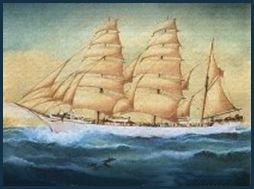Sea Shanties, Sea Music, Sea Songs- TheSeaShanty.net
Sea Shanties, Sea Music, Sea Songs...What are they?
Sea Shanties, also known as sea music or sea songs, are the work
songs of the sea that helped sailors synchronize their hard and repetitive
tasks, so they could labor more efficiently and safely. Singing sea
shanties provided
several benefits: a diversion for the mind, avoiding boredom, lightening
the burden of mundane tasks, and expression of sailors' views which would
otherwise not be tolerated.
"Shanties were labour songs sung by sailors of the merchant service only while at work, and never by way of recreation. Moreover—at least, in the nineteenth century—they were never used aboard men-o'-war, where all orders were carried out in silence to the pipe of the bo'sun's whistle.
Before the days of factories and machinery, all forms of work were literally manual labour, and all the world over the labourer, obeying a primitive instinct, sang at his toil: the harvester with his sickle, the weaver at the loom, the spinner at the wheel. Long after machinery had driven the labour-song from the land it survived at sea in the form of shanties, since all work aboard a sailing vessel was performed by hand.
The advent of screw steamers sounded the death-knell of the shanty. Aboard the steamer there were practically no sails to be manipulated; the donkey-engine and steam winch supplanted the hand-worked windlass and capstan. By the end of the seventies steam had driven the sailing ship from the seas. A number of sailing vessels lingered on through the eighties, but they retained little of the corporate pride and splendour that was once theirs. The old spirit was gone never to return."*
Basic Sea Shanty / Sea Music Types

"Sea Shanties may be roughly divided, as regards their use, into two classes: (a) Hauling shanties, and (b) Windlass and Capstan. The former class accompanied the setting of the sails, and the latter the weighing of the anchor, or 'warping her in' to the wharf, etc. Capstan shanties were also used for pumping ship. A few shanties were 'interchangeable,' i.e. they were used for both halliards and capstan. " * (Here's more information on shanty types).
Sea shanties and shanty houses- Any connection?
Here is a very interesting quote which asserts that there is: "West
Indian negro shanties are movable wooden huts, and when a family wishes
to change its venue it does so in the following manner: The shanty is
levered up on to a low platform on wheels, to which two very long ropes
are attached. The ropes are manned by as many hands as their length
will admit. A 'shantyman' mounts the roof of the hut and sits astride
it. He sings a song which has a chorus, and is an exact musical parallel
of a seaman's 'pull-and-haul' shanty. The crowd below sings the chorus,
giving a pull on the rope at the required points in the music, just
as sailors did when hauling at sea. Each pull on the rope draws the
hut a short distance forward, and the process is continued till its
final resting-place is reached, when the shantyman descends from the
roof. The hut is then levered off the platform on to terra firma and
fixed in its required position.
Here, at least, we have a very ancient custom, which would be familiar
to British seamen visiting West Indian seaports.
The object moved was a shanty; the music accompanying the operation was
called, by the negroes, a shanty tune; its musical form (solo and chorus)
was identical with the sailor shanty; the pulls on the rope followed
the same method which obtained at sea; the soloist was called a shantyman;
like the shantyman at sea he did no work, but merely extemporized verses
to which the workers at the ropes supplied the chorus; and finally, the
negroes still pronounce the word itself exactly as the seaman did. I
am quite aware of the flaws in the above argument, but at least it shows
a manual labour act performed both afloat and ashore under precisely
similar conditions as to (a) its nature, (b) its musical setting; called
by the same name, with the same pronunciation in each case; and lastly,
connected, in one case, with an actual hut or shanty." * (back
to top)
